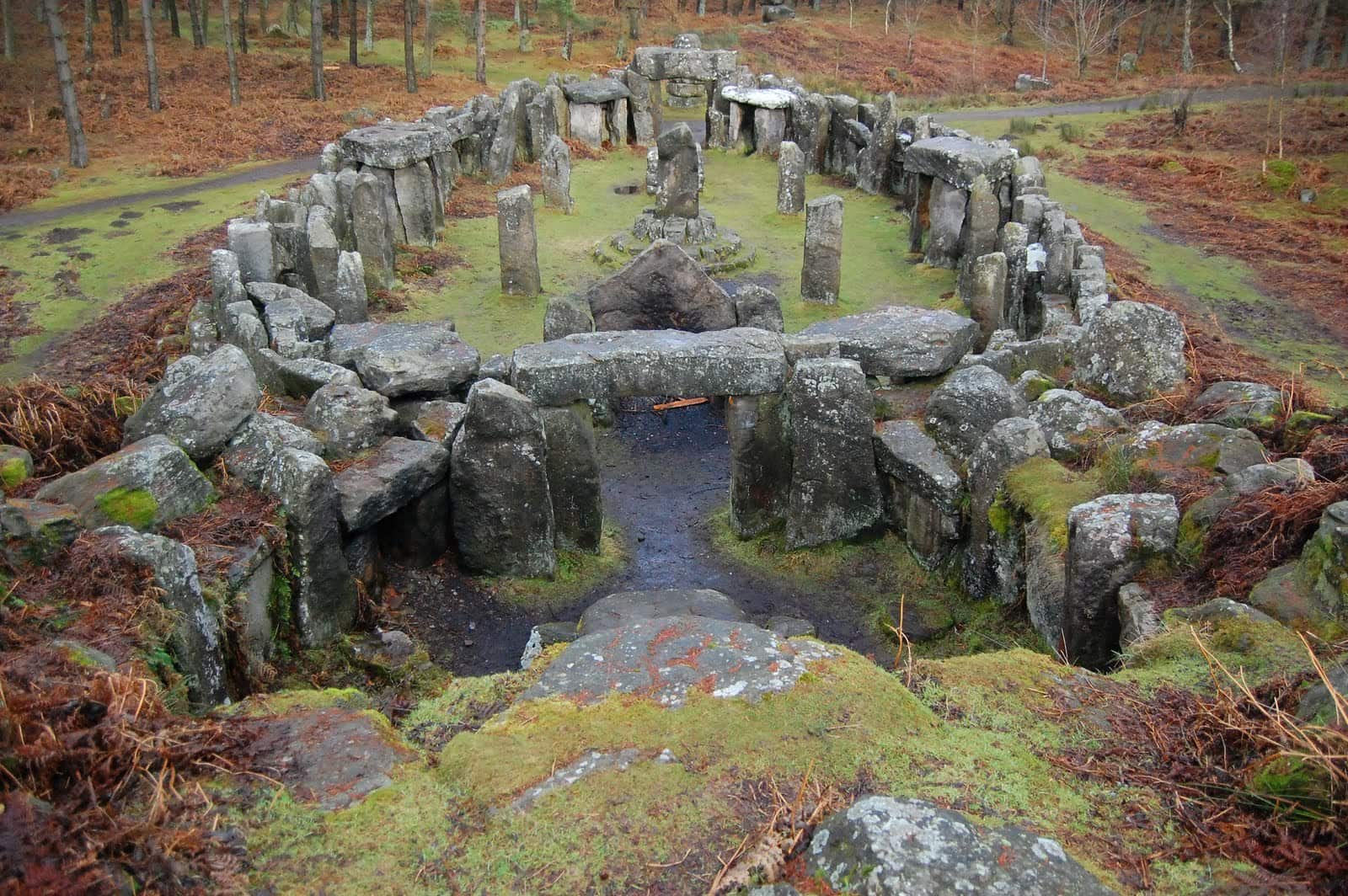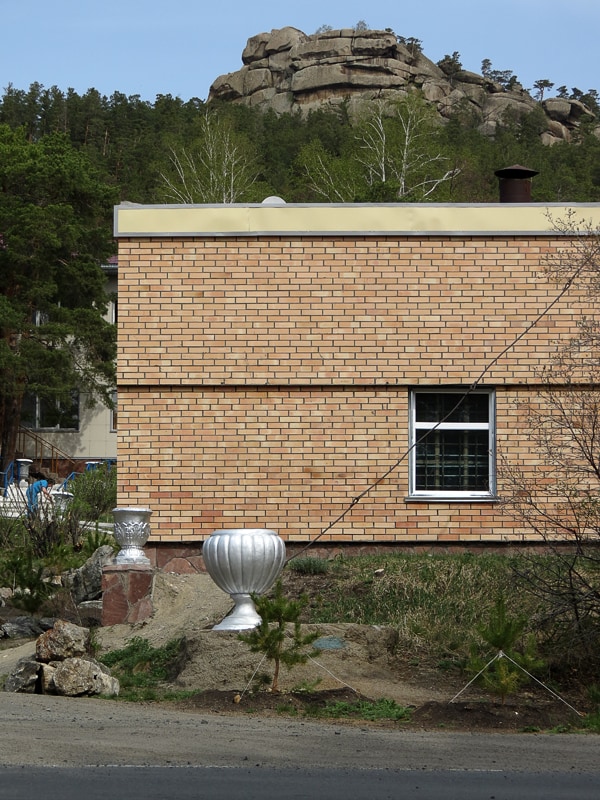It would be right to start with the terminology, as it is customary among educated people. However, taking into account that this publication is not completely scientific, I can allow myself some deviations from scientific style. Nevertheless, it would be also unfair to sacrifice objectivity. So, speaking of megaliths, can we use this term relating to rocks-remnants? From the standpoint of official science – no.
Megalith, what are you?
Here is one of the definitions:
The word "megalith" comes from the Ancient Greek "μέγας" (transl. mégas meaning "great") and "λίθος" (transl. líthos meaning "stone"). It is a large stone that has been used to construct a structure or monument, either alone or together with other stones. The word "megalithic" describes structures made of such large stones without the use of mortar or concrete, representing periods of prehistory characterized by such constructions. For later periods, the term monolith, with an overlapping meaning, is more likely to be used. [Wikipedia].
The term itself was adopted for general use just recently, in the middle of the 19th century. Its defenition was quite vague, so it had to be clarified over time. Currently the term «megalith» may refer to: chromlechs,
Menhirs,
Dolmens (triliths),
As well as so-called «temples» category, which includes all kinds of things that are inexplicable to scientists (from Egyptian pyramids to fantastic constructions in South and Central America.)
Later on, the term also absorbed such objects as:
- taula – T-shaped stone construction;
- trilith - a structure consisting of two large vertical stones (posts) supporting a third stone set horizontally across the top;
- seita – another type of stone formation;
- cairn – pile of stones, usually serving as landmark/trail marker;
- covered arcade;
- boat-shaped tomb.
For now, it seems like everything is clear and logical. «Megas» - means big, «lithos» - means stone. Let us open a Russian-Greek dictionary and look up the word «камень» (stone). Here we find a small revelation. It turns out that the word «stone» translates in Greek as «πέτρα» (Petra). What about «lithos»?
We have to abstract again and forget everything we know about the ancient Greeks from history books in order to apply logic. No matter how many times I’ve been told that meteorology is a science of atmospheric phenomena, my mind sees some other sense in this word, that is apparent from the word itself. «Meteor» is a root of the word «meteorology», which means that this science is about meteors (shooting stars), but not about weather. It is fully confirmed by the fact that the official meteorological office of the Russian Empire used to exist at least since the middle of the 18th century, notably – in every major city.
No matter how many times it has been said that this office kept track of weather changes, the surviving reports from the whole Empire (that used to be sent to and stored at the Science Academy in St. Petersburg) reveal completely another purpose of the office. Regular reports contain information solely related to shooting stars, but nothing about weather.
Situation with terminology based on Greek language is not that simple, however there are quite a lot of reasons to consider Greek language to be a modern, artificially created one. It could be clearly seen in the framework of «ancient» Greek words. It is a common practice when words, adopted from another language, transform and get new prefixes and flexions, such as: «ас», «ис», «ус», «сис» and so on. This way Alexey transformed into Alexis, Andrey into Andreas, Dmitriy into Dimetrius. The same situation is seen today in Baltic region, where, for example, Russian last name Kulikov turns into Kulikauskas.
Thus, it is not surprising that native speakers of Slavic languages find many Greek words so familiar. It cannot be otherwise. Any artificial language inevitably borrows words from other languages. That’s why we so surely relate the word «lithos» to verb «лить» (to pour).
We may also suggest that the words «stone» and «lithos» are not the same. Natural stone is «petra» (Петроград/Petrograd (St. Petersburg) – literally means «stone city»), while artificial (philosophers') stone is made by casting. Everyone heard about alchemists and their (possible) knowledge of philosophers' stone secrets. The word «alchemistry» itself means «casting» in Greek language (χυμενσιζ).
All of it indirectly confirms our theory, giving it right for existance. Stone is stone, but «megalith» is a «big casting». It is also worth mentioning that one of the oldest names of Egypt is Keme. Сoincidence? I don’t think so.
Megaliths should be classified into two main categories/groups:
- Megaliths casted with encasement, presented by the so-called geopolymer concrete;
- Natural stones, processed using hand or mechanical tools.
Each of these two groups should be divided into two sub-groups, according to date of creation and then all four groups should be classified by purpose (functionality). In my opinion, this is the most intriguing part because the main point in an argument between supporters of aritificial origin theory and their opponents is a question of functionality of controversial objects.
Skeptics tend to deny the artificial origin theory even in cases where a megalith has obvious traces of aritificial processing, like separate blocks of regular shape, with different mineral composition.
They usually say something like this: “Let us assume that these objects are artificial, then where are doors and windows? Where are stairs, inner rooms? They can’t be used as defensive objects either. If it has no functional purpose, then there was no need to construct it in the first place, which leads us to the conclusion that these objects are of natural origin.”
Hold on a second, what about pyramids? Do you really think that they are pharaohs’ tombs? After about 200 years of active research, scientists (and sceptics) haven’t achieved any real success in understanding the true purpose of pyramids. For them, any inexplicable object is either a shrine, a tomb, an observatory, or some kind of temple made in honor of some god or goddess. They are like savages that, upon seeing a train for the first time, have no clue about its purpose. If explanation is absent from textbooks, they find themselves at a dead end.
So I have a perfect right to ask them – how can they even make any discoveries if they are so dependent on scientific dogmas? What a paradox. That’s why I don’t ask conventional scientists to look at the Borovoe lake in The Burabay National Park, Kazakhstan, but those who are inquisitive and friendly are welcome.
Burabay lake.
The Burabay National Park was created in 2000 to preserve the nature, promote tourism and provide recreation for the locals. It is located in Aqmola Region of Kazakhstan with the overall territory of around 130 000 ha.
The park occupies the Burabay mountain-forest group, located in the eastern part of Kokchetau highland. Top height of the Kokchetau ridge is 887 meters (Sinyuha town). The ridge is made of abyssolithic magmatic rocks, mainly granite.
You can also find there pegmatites, syenites and porphyrites. Molten magma, that once broke out of the depths of earth, transformed the composition of surficial sedimentaries and formed new metamorphic rocks – crystallized cleaving rocks, quartzites, silicious lime rocks.
After a thousand-year ablation and eolation process, new rocks of bizarre shape have appeared, resembling towers, walls, tables and monsters.
Various picturesque lakes can be found in Burabay: Burabay lake, Shuchie, Kotirkol, Bolshoe and Malenkoe Chebachie, Karasie, Svetloe and others. Most of the lakes have fresh water, but some have saltish water. There is also a branchy network of rivers and streams (Saribulak, Gromovaya, Kolchakti, Kilchakti, Imanay stream and others).
Burabay lake (Photo by Peter Ushakov).
I am wondering what it feels like to live in a house, located in the middle of an ancient city...
As usual, I investigate an area with the help of the well-known app Google Earth.
An unusual shape of the area where Burabay ruins are located immideately catches the eye. These are indeed ruins, but not remnant rocks. It is another indirect proof that the territory of modern Kazakhstan used to be a group of islands amidst sea. The heaths observable around were once an ocean floor, and lakes – remains of the Tethys Sea.
Radial shape of the highland, where The Burabay National park is located, reminds of the lost Atlantis.
After zooming in, I noticed that the former island is covered by a giant grid of straight lines, which divide the whole area into squares of regular shape! Any specialist would confirm that it is extremely hard to maintain such straight lines during construction of roads, pipelines, ETLs and others. Obstacles usually force such lines to be curved, but here we see kilometers of absolutely straight lines, covering the whole «island» with grid. What made the creators of this cut the trees in such a peculiar way? Particularly taking into account the incredibly rough and uneven terrain.
Looking at the image with maximum zoom, I assured myself that these are not roads or pipelines. These are clearcuts, partially used as by-roads, that have mainly become overgrown with thick forest, but are still clearly seen.
Recently, an article by Alexey Artemiev (a researcher from Izhevsk) about mysterious grids in Vyatsk forests, created a stir among alternative history followers. The grids described in his article divide the forests into squares of surprisingly regular shape. At first, it looks like a result of some forest workers’ activity, probably during USSR period. But if you measure any line of that grid, you find out that it equals 1066.8 meters – a traditional (appeared before USSR) Russian unit of distance, called «verst» (0.6629 mile). So if it was made by someone before the USSR period, then how could it all be accomplished without modern equipment? A work like that would require colossal human efforts and time, making it almost impossible. Another question is – why does the grid never get overgrown?
I’ve measured a side of the square and was not even surprised. It equaled one verst too. You can check it yourself.
Suggestion that these grids are somehow related to cardinal directions didn't put any clarity into the problem. If the deviation from the North Pole direction was the same in the opposite direction, then we could speculate that these grids are oriented to the old North Pole, that was situated before the catastrophe on the territory of modern Greenland. It should also be noted that such grids are found mainly in the places barely touched by nature or humans.
I am almost sure that all these objects are comparable to the ones found in Egypt. The only difference is that Khazakhstanian ruins were damaged in a much greater degree than those found in Egypt.
The forces of nature were not the only factors that influenced these constructions throughout the ages, there had been something that severly damaged them initially. Some factor that is only possible during a global catastrophe, when no stone is left upon another.
A natural rock does not shatter into blocks of regular shape.
The blocks that you see in the lower right corner leave no chance to those who assert that these stones are of natural origin. There are no straight lines in nature. Nature always tends to erase anything flat, smooth, that has straight edges, corners and sides. It can’t create a rectangular stone or a radial hole, only ellipses of irregular shape.
The lower part (2.5 m) looks like it was under water just recently, while the upper part demonstrates what happens to natural stones throughout ages being slowly destroyed by winds and other factors. This is how nature treats artificial constructions.
There are no doubts that these are indeed artificial stone blocks and not spread monolith.
This is the look of traces of destruction of monolithic rocks. As we see, it is incomparable to the objects in Burabay, although their mineral composition is very similar.
Two things come up in mind when looking at this picture: - ruins of classical pyramid and paraboloidal mirror, found in many places on Earth (mount Kailash, Ergaki mountains, Bayanaul national park and others). It is when the question of determinating the age of theses objects is thrown into sharp relief. Without adequate and reliable methods of determinating the age of such objects it is impossible to find out what is older, the Giza pyramids or constructions in Burabay. The methods used by geologists give inaccuracies that equal to millions of years, which make such «scientific» methods and tools irrelevant.
The problem of determinating the age is not the only one. There have been cases when several labs, working independently from each other, gave exactly opposite results of mineral composition analysis, sampling the same stone that had been taken from an Egyptian pyramid. One lab concluded that the stone was natural, while the other stated that it was artificial.
Those who have been in Brest Fortress will surely see the similarity with bricks that were melted with German flame flamethrowers.
Even though I concede an option that this is just natural erosion, all speculations should be considered until any research is conducted.
It strongly resembles the damaged Sphinx statue, found near Giza pyramids. Were there any pyramids? Yes, there were, and more than one.

The sea probably splashed right at the foot of the walls. These walls could actually be docks, or quays. The place from where the photographer shoots used to be at a depth of about thirty meters.
Is it not obvious that this was a pyramid? A half of it simply collapsed. There are other pyramids nearby that are smaller. Everything is exactly like on the Giza plateau.
So, we examined the second type of remnants, which is very similar to the natural one. But in fact, it is most likely artificial. Like Bayanaul, it is very ancient, but the differences are significant. If Bayanaul emerged from granite layers, then objects in the Burabay town have vivid traces of construction using large stone blocks. The technology used to construct those objects is most likely similar to the one used in the construction of the Egyptian pyramids.
Another difference lies in their purpose. If Bayanaul is similar to the polygon of miners who extracted metal using the method of underground leaching, then Borovoe is a complex of utilitarian facilities. The appointment is incomprehensible to us, for now, but surely the day will come when there will be clarity in this matter. Indeed, even more recently, we could not understand the nature of layered remnants. The joint efforts of my friends from Krasnoyarsk (sibved and Sergey Isofatov) allowed us to formulate a rather convincing theory about the origin of some types of remnants, and find a few more indirect facts that confirm the version of anthropogenic terraforming. However, this issue will be discussed in further articles.










































